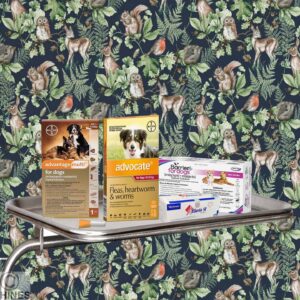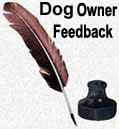Heartworms, The Slow Kill Versus The Fast Kill Treatment?
Ron Hines DVM PhD

 This photo shows you some of the current monthly heartworm preventatives that are based on moxidectin. The article below is about the treatment methods available to your veterinarian – if your dog becomes heart worm positive. But you don’t need to wait for your dog to contract heartworms to obtain the benefits of moxidectin. I practice in a high canine heartworm infection area in south Texas. It is hot, it is humid, and there are a considerable number of seasonal bogs that are ideal places for mosquitos to breed. Moxidectin-based heartworm products are the only ones I suggest for dogs living in this sort of environment. That is because moxidectin persists in your dog’s body longer than ivermectin or the other avermectin-containing heartworm preventatives do. So, when given as directed, it gives your dog a full month of protection from a single topical application. Other products, given at their recommended dose intervals, might not persist at high enough levels to protect your dog for a full 30 days. That is particularly important if, for some reason, the following month’s dose is forgotten. We all forget things now and then. I suggest that you purchase topical heartworm preventatives whenever you can. If you apply topical medications, and your dog has a reaction, you can wash it off with soap and water. But if you give a medication orally or by injection and a reaction occurs, that option is not available to you. That is why I am not a fan of the 6-month or 12-month moxidectin injections which are also available. My only exceptions would be when one of those two products is used intentionally to treat a dog that is already infected with heartworms, or in situations where monthly topical applications are not feasible.
This photo shows you some of the current monthly heartworm preventatives that are based on moxidectin. The article below is about the treatment methods available to your veterinarian – if your dog becomes heart worm positive. But you don’t need to wait for your dog to contract heartworms to obtain the benefits of moxidectin. I practice in a high canine heartworm infection area in south Texas. It is hot, it is humid, and there are a considerable number of seasonal bogs that are ideal places for mosquitos to breed. Moxidectin-based heartworm products are the only ones I suggest for dogs living in this sort of environment. That is because moxidectin persists in your dog’s body longer than ivermectin or the other avermectin-containing heartworm preventatives do. So, when given as directed, it gives your dog a full month of protection from a single topical application. Other products, given at their recommended dose intervals, might not persist at high enough levels to protect your dog for a full 30 days. That is particularly important if, for some reason, the following month’s dose is forgotten. We all forget things now and then. I suggest that you purchase topical heartworm preventatives whenever you can. If you apply topical medications, and your dog has a reaction, you can wash it off with soap and water. But if you give a medication orally or by injection and a reaction occurs, that option is not available to you. That is why I am not a fan of the 6-month or 12-month moxidectin injections which are also available. My only exceptions would be when one of those two products is used intentionally to treat a dog that is already infected with heartworms, or in situations where monthly topical applications are not feasible.
In 2023, a group of Italian veterinarians published an article on the effectiveness of a moxidectin/doxycycline treatment for heartworm positive dogs. Read that study here. In that study, thirty heartworm positive dogs, obtained from an Italian animal shelter, that were positive for heartworm, were divided into three groups of ten. All three dog groups were given oral doxycycline @ 10 mg/kg for the first 30 days to destroy wolbachia. Doxycycline is thought to destroy the wolbachia that live inside of heartworms. Without those organisms, heartworms lose some of their strength.
![]() One of the groups began oral moxidectin at 3 µg/kg once a month for 9 months (that is the standard oral dose for moxidectin-based monthly heartworm preventatives).
One of the groups began oral moxidectin at 3 µg/kg once a month for 9 months (that is the standard oral dose for moxidectin-based monthly heartworm preventatives).
![]() The second group of ten dogs were given the same 30-day oral doxycycline dose, as well as the suggested dose of topical flea and heartworm preventative drops (Advocate®/Advantage Multi) once a month for 9 months.
The second group of ten dogs were given the same 30-day oral doxycycline dose, as well as the suggested dose of topical flea and heartworm preventative drops (Advocate®/Advantage Multi) once a month for 9 months.
![]() The third group of ten dogs were given the same oral 30-day doxycycline dose along with an injectable, extended release moxidectin injectable product (Afiliara SR®) at 0.17 mg moxidectin/kg. That product is not available in North America and the dose used needs to be confirmed because their dose is not mentioned in the first article I linked to, but a dose is mentioned in a previous publication by the same authors. (read here) Two subcutaneous shots were given, one at the beginning of the trial and another, six months later. This is the same dose recommended by Zoetis for their Proheart-6®, every-six-month, injection heartworm preventative. Not all of their dogs tolerated their injectable moxidectin drug well. In 2004, the then manufacturer of Proheart-6, Fort Dodge, recalled the product at the request of the FDA. After the directions for use of the product were revised, the FDA allowed Proheart-6 to reappear on the market – this time as a Zoetis product. It is now sold with the label warning that it might be unsafe to administer to elderly dogs or dogs that are underweight for their age or breed standard (the average weight of the breed) – remember, moxidectin is stored in your pet’s body fat. Zoetis also requires that dogs that receive Proheart-6 be 6 months of age or older. They mention that it might cause non-serious swelling, pain or an inflammatory bleb at the site of injection. However, the authors of a more recent study of the Italian product found that when side effects did occur, they were usually mild. (read here) A point not mentioned, but probably true, is that overweight dogs might require a different (lower?/higher?) dose. (read here) That is also because moxidectin binds to body fat, if it’s not in circulation, it is not going to reach the heartworms.
The third group of ten dogs were given the same oral 30-day doxycycline dose along with an injectable, extended release moxidectin injectable product (Afiliara SR®) at 0.17 mg moxidectin/kg. That product is not available in North America and the dose used needs to be confirmed because their dose is not mentioned in the first article I linked to, but a dose is mentioned in a previous publication by the same authors. (read here) Two subcutaneous shots were given, one at the beginning of the trial and another, six months later. This is the same dose recommended by Zoetis for their Proheart-6®, every-six-month, injection heartworm preventative. Not all of their dogs tolerated their injectable moxidectin drug well. In 2004, the then manufacturer of Proheart-6, Fort Dodge, recalled the product at the request of the FDA. After the directions for use of the product were revised, the FDA allowed Proheart-6 to reappear on the market – this time as a Zoetis product. It is now sold with the label warning that it might be unsafe to administer to elderly dogs or dogs that are underweight for their age or breed standard (the average weight of the breed) – remember, moxidectin is stored in your pet’s body fat. Zoetis also requires that dogs that receive Proheart-6 be 6 months of age or older. They mention that it might cause non-serious swelling, pain or an inflammatory bleb at the site of injection. However, the authors of a more recent study of the Italian product found that when side effects did occur, they were usually mild. (read here) A point not mentioned, but probably true, is that overweight dogs might require a different (lower?/higher?) dose. (read here) That is also because moxidectin binds to body fat, if it’s not in circulation, it is not going to reach the heartworms.
All dogs in the Italian study were checked periodically for the presence of heartworms using the Idexx PetChek HTWM PF® heartworm test. That test detects only the more dangerous adult female heartworms through the presence of an antigen that only they possess. By the end of two months, there was a noticeable decrease in the amount of this heartworm antigen present. Nine months from the beginning of the study, the majority of the dogs tested negative for heartworms. Of the three methods of treatment given, the injectable form of moxidectin appeared to be slightly more effective than the oral or topically applied moxidectin products. But since there were only ten dogs in each group, one cannot really be sure.
What About The FDA-Approved Fast Kill Method?
I, too, would like to see your dog rid of heartworms as quickly as possible. The Fast kill method using melarsomine is still the first choice of the American Heartworm Society, a group funded by the two manufacturers of Immiticide®, Diroban® as well as Idexx, the manufacturers of the most widely used heartworm test. They claim that after a two-dose melarsomine treatment, 90% of the heartworms are usually killed. The American Heartworm Society claims that after a three-dose melarsomine treatment, 98% of the worms are usually killed. Since dogs must be sacrificed to confirm post-treatment heartworm numbers (remember, male heartworms and female heartworms not yet mature don’t register on the tests) those percentage figures are rather soft.
I wish we veterinarians had better treatment options to offer you. If your dog was found to be heartworm positive on its yearly checkup, but still appears healthy (asymptomatic) or perhaps has developed no more than a mild, intermittent cough. And if its labwork results are close to normal, it should go through its melarsomine treatment just fine. The higher risk patients are usually the dogs with many heartworms, where the worms have done their heart and lung damage over an extended period of time.
The product inserts for the two fast kill melarsomine products, Diroban®-Zoetis/Immiticide®- Boehringer Ingelheim, have even more warnings than the moxidectin products. The severe warnings are aimed at the high-risk dogs: That it is not to be used, or used with high caution in the late heart failure stages of heartworm disease. That it must be used with caution in older dogs. That exercise and agitation must be strictly restricted during and after treatment. That the drug has a low margin of safety. That injection site reactions are common. But Zoetis claims that serious reactions only occur in 1.5% of the dogs to which it is administered. The Heartworm Society also mentions in a roundabout way that in some dogs, not all of the adult female worms will be destroyed, as evidenced by a positive heartworm antigen test after treatment. And that a second treatment might be required. They punt and leave that decision to you and your veterinarian. A third method, occasionally performed in late heartworm disease (caval syndrome) is surgical removal of some of the adult heartworms. (read here) I have attempted that with mixed success. It needs to be performed at a large veterinary center by someone experienced in the technique.

If your dog or your animal rescue uses the slow kill method, I would appreciate you letting me know your thoughts about this method of heartworm treatment and the way it is performed at your facility.
*************************
You are on the Vetspace animal health website
Visiting the products that you see displayed on this website help pay the cost of keeping these articles on the Internet.


